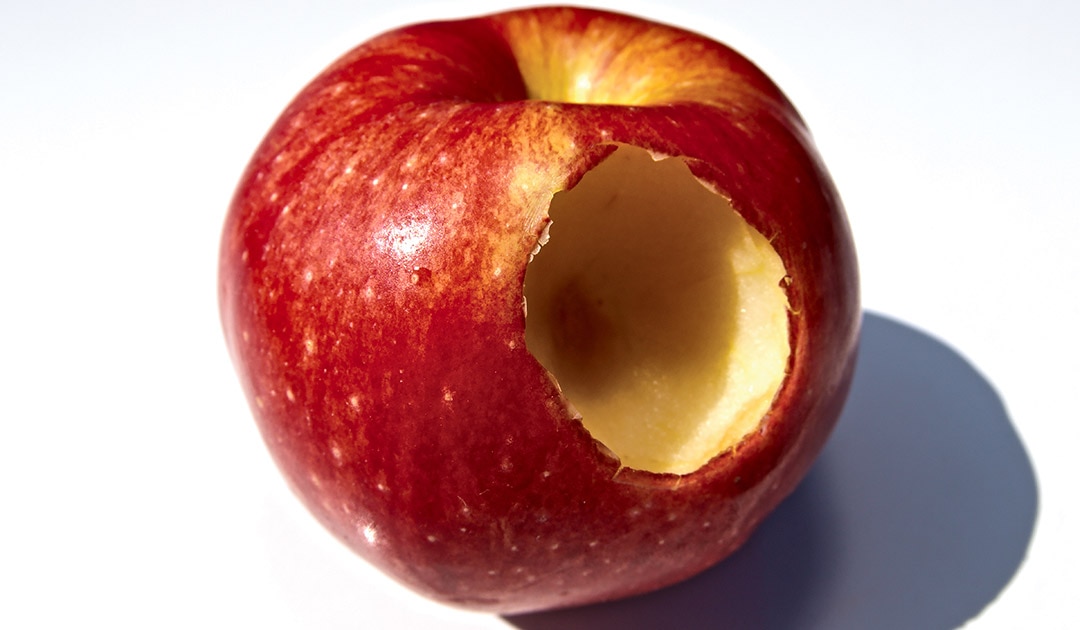What Did Eve Eat In The Garden
Eve and the forbidden fruit
The Old Testament tells of Adam and Eve, our progenitors. They lived in paradise in total innocence until the serpent (the devil) enticed them to eat the forbidden fruit from the tree of knowledge. As punishment for their disobedience, God banished them from Paradise. Why is the forbidden fruit often called an apple?

© Shutterstock / Deep Desert Photography
Genesis chapter 3 of the Bible recounts the story of Adam, the first man God created, and the woman God formed from one of Adam's ribs. They lived piously in the Garden of Eden until the serpent, craftier than the other animals, led the woman into temptation. The serpent said, "Did God actually say 'You shall not eat of any tree in the garden?'" The woman answered, "We may eat of the fruit of the trees in the garden, but God said, 'You shall not eat of the fruit of the tree that is in the midst of the garden, neither shall you touch it, lest you die.'" The serpent replied, "You will not surely die. For God knows that when you eat of it your eyes will be opened, and you will be like God, knowing good and evil." Since the woman sought wisdom, she ate the fruit of the tree, and gave some to Adam to eat too. "Then the eyes of both of them were opened, and they knew that they were naked." When God came into the garden, they hid from him. He noticed that they had eaten the fruit of the tree of knowledge, and turned them out of Paradise. "To Adam he said, 'Because you have listened to the voice of your wife and have eaten of the tree of which I commanded you, 'You shall not eat of it', cursed is the ground because of you; in pain you shall eat of it all the days of your life; thorns and thistles it shall bring forth for you; and you shall eat the plants of the field. By the sweat of your face you shall eat bread, till you return to the ground, for out of it you were taken; for you are dust and to dust you shall return." After the fall, Adam named his wife Eve (which means 'life' in Hebrew), as the mother of all living, the progenitrix of all human beings.
Theology refers to this incident as the 'fall of man' as, against God's will, he ate the fruit that allowed him to distinguish good from evil. The Bible does not actually mention an apple – early Christian art depicts the Fall of Man by a fig. Christianity likely introduced the idea of the fruit being an apple, in recollection of the 'apple of paradise' or when the Bible was translated. In Latin, evil is malum and an apple is called malus . This could have been either a simple mistranslation or a deliberate play on the these words. An apple already featured in one of the earliest depictions of the Fall of Man from the 2nd century CE in the catacombs of San Gennaro in Naples.
According to the Christian doctrine, original sin, also known as ancestral sin, is a consequence of the fall of man. As descendants of Adam, all human beings are born into sin. Yet it also draws a connection between the tree of knowledge and the salvation of man. The tree is equated with the cosmic 'world tree', the 'path to eternity', the tree of life planted on Calvary. Jesus takes the way of the Cross as a sacrifice to save man from sin. In this respect, Jesus is the new Adam. Adam is disobedient, because he ate fruit from the forbidden tree, while Jesus is obedient, allowing himself to be nailed to a cross, the tree of Calvary, to atone for Adam's sin. In the Middle Ages and modern times, an apple represents overcoming original sin, often depicted as a snake with an apple in its mouth – as in English Greeting by Veit Stoss (Lorenzkirche, Nuremberg). Depictions of the Madonna also often include an apple, since Mary, as the new Eve, symbolises overcoming sin.
Sources:
- Buch Genesis, zit. nach https://www.uibk.ac.at/theol/leseraum/bibel/gen3.html [11.04.2017]
- Liselotte Stauch, Apfel, in: Reallexikon zur Deutschen Kunstgeschichte, Bd. I (1935), Sp. 748–751; in: RDK Labor, URL: http://www.rdklabor.de/w/?oldid=89425 [21.10.2016]
- Original: Mircea Eliade, Histoire des croyances et des idées religieuses, Édition Payot, Pris 1978, 1992
- Deutsche Ausgabe: Mircea Eliade, Geschichte der Religiösen Ideen, 4 Bände, Freiburg (Herder) 1979
What Did Eve Eat In The Garden
Source: https://www.alimentarium.org/en/knowledge/eve-and-forbidden-fruit
Posted by: pettitsuded1943.blogspot.com

0 Response to "What Did Eve Eat In The Garden"
Post a Comment